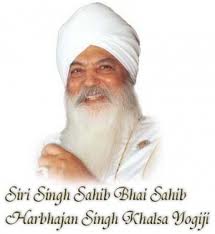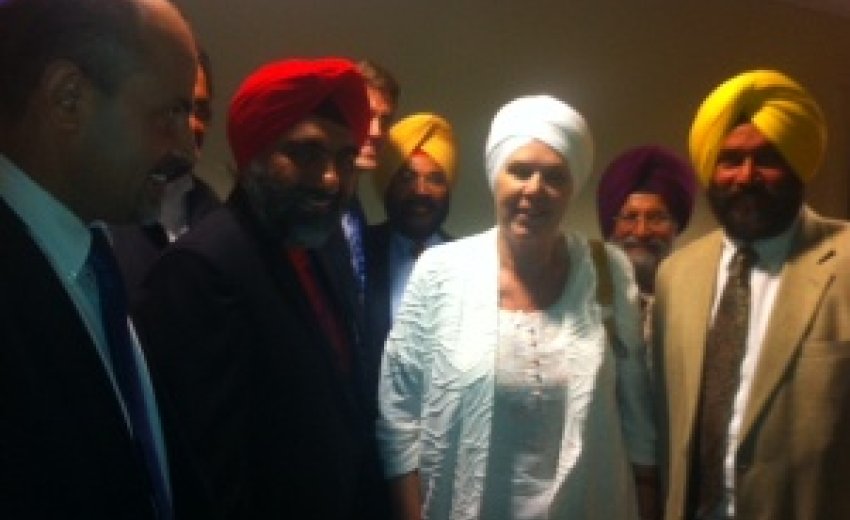| Photo of Siri Pritham Kaur Khalsa of Yuba City, right after she spoke in front of the California Board of Higher Eduction @ the State Capitol in Sacramento on Tuesday, March 19, 2013, about the need to include the teaching of Sikhism into the curriculum of Religion classes taught at CA Universities. Leading members of the Sikh community came together to secure passage of ACR 20: the bill that will include Sikhism in Religion classes on the University level, which so far only is the case in only two out of 32 Universities. |
The bill was introduced by Dan Logue, R, of Yuba County - a good friend of the Sikh community.
The resolution was approved with all members voting for it, none against or abstaining.
Thank you Siri Pritham Kaur and the other Sikhs and California legislators who have helped to evolve the progress of teaching Sikhism in college and university curriculums in the state of California. Its fitting that this takes place during the 100th anniversary of the Ghadar Party forming in Astoria, Oregon in 1913 and eventually relocating its headquarters to San Francisco.
Siri Pritham Kaur's presence testifying in front of the California Board of Higher Education in Sacramento is a testament to the legacy of Siri Singh Sahib Harbhajan Singh Khalsa (Yogiji) her spiritual teacher.
This moment in history is needed and hopefully will evolve into other state's University World Religion programs.
I would like to share some history on Sikhism in college world religion programs in the United States.
Sikhism was first taught at Brevard Community College in Cocoa, Florida by Dr. Byron Lindley ("Lin") Osborne Jr. (1971). Siri Singh Sahib ji was invited to lecture at BCC in November of 1971. Dr. Osborne was the first professor of World Religion to actually include Sikhism as a separate World Religion using a 360 degree wrap around nine screen presentation, including Gurbani. He also wrote his own World Religion book with a separate chapter on Sikhism.
 Dr. Osborne, a former Methodist minister and PhD, first approached the University of Florida system to put together a uniquely diverse World Religion program for his college students in 1970. The University of Central Florida now has this as part of its program. Dr. Osborne loved his first meeting with the Yogi Bhajan. His presentation has never been replicated to the best of my knowledge. He was ahead of his time. Normally there are a lot of books used in college curriculum. Dr. Osborne was successful in asking the President of the college to invest in a separate building just to 'experience' the different World Religions both visually and audibly. He would travel to Amritsar and other holy places in India filming and shooting pictures (thousand of them) to share in his courses each semester.
Dr. Osborne, a former Methodist minister and PhD, first approached the University of Florida system to put together a uniquely diverse World Religion program for his college students in 1970. The University of Central Florida now has this as part of its program. Dr. Osborne loved his first meeting with the Yogi Bhajan. His presentation has never been replicated to the best of my knowledge. He was ahead of his time. Normally there are a lot of books used in college curriculum. Dr. Osborne was successful in asking the President of the college to invest in a separate building just to 'experience' the different World Religions both visually and audibly. He would travel to Amritsar and other holy places in India filming and shooting pictures (thousand of them) to share in his courses each semester.
He traveled to Egypt to experience the ancient mysteries of Africa. He explored Islam in Mecca and around the world. He went to Jerusalem to discover Judaism and Christianity. In India he went to Sacred places in south and central India so he could share the history of Buddha and Krishna and Ram.
Typically, a student (age 18-50+) would sign up for his curriculum with excitement and anticipation. Each semester his classes were always full. Unlike California with its diverse population, Florida is primarily protestant (Christian) populated state. Dr. Osborne's presentations at BCC were unique forty years ago. Even during that time World Religion's normally included Hinduism, Buddhism, Judaism, Christianity, Islam and maybe Taoism. No one knew of Sikhism or if they did, it was included as a part of Hinduism.
Dr. Osborne expanded the education of this format. He actually went to Siri Harimandir Sahib and other historic Gurdwaras in India, gathering images, Kirtan and sounds of the people and stories to tell.
Members of Baba Siri Chand Ashram, 50 miles away in Altamonte Springs, Florida were invited to speak and share teachings of the Gurus with his classes.
Imagine being 35 students, who signed up for this World Religion class each semester. You come into this beautiful theater on campus with wrap around screens and a very sophisticated sound system. (much like EPCOT Center at Disney). You move around on swivel chairs which allow you to see 360 degrees and suddenly there is a beautiful KHANDA on the center screen, Gurbani is playing and the other 8 screens open to the Parakarma of the Golden Temple which now surrounds you. As the music continues you are visiting Darbar Sahib as pilgrims do each day in the Amrit Vela. This was the beginning on Dr. Osborne's course on Sikhism. He taught the history, teachings of Siri Guru Nanak and the other nine Sat Gurus. He covered Sikh history in India, the British Raj, and its evolution to America. He also focused on the worship of One Creator and the Guruship of Siri Guru Granth Sahib. He even showed a Sikh Sardar and his wife stretching and folding a turban, then showing how it is tied. Students learned about the five "Ks" and the reasons Sikhs don't cut their Kesh.
So for historic purposes not to get lost in the evolution of education in America, I thought we could remember a "Pioneer" of education. Over forty years ago, Sikhism was a curriculum in one Florida college in the US. Even at Harvard Divinity School, Sikhism was not included as part of the curriculum. This may have changed over the years as Dr. Harvey Cox and Diana Eck were both knowledgeable about Sikhism.
Dr. Osborne has passed on to his Creator in 2012 at the age of 90. He was 7 years older the Siri Singh Sahib ji when they met. Dr. Osborne was born in Cleveland, Ohio, July 22, 1922, of Byron and Ruth Osborne. He graduated from Yale Divinity School and received a Doctor of Theology degree from Concordia Seminary in St. Louis, Missouri.
Rev. Dr. Lin Osborne pastored Methodist churches in Connecticut, Missouri, and Florida. He was Professor of Religion and Philosophy at Stephens College in Columbia, Missouri. Then he was Professor of World Religions at Brevard Community College in Cocoa, Florida, and the University of Central Florida from 1965 until he retired in 2003. Lin was passionate about making his student's experience come alive and was a pioneer in designing a multimedia classroom surrounded by screens. He created and presented shows that immersed students in a dramatic understanding of the world's religions through his use of colorful images, powerful audio, description, stories, and interaction. Dr. Lin Osborne was named BCC's 1996 Distinguished Educator.
I would like to acknowledge his presence in our lives and publicly thank his efforts.
Bole Soni Hal, Sat Siri Akal!
humbly submitted,
S.S. Sat Hanuman S. Khalsa
Portland, Oregon

